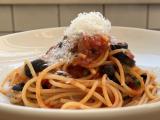Quick Ricotta and Lemon Pasta (One Pot Pasta)
Table of Contents
Jump to Recipe
Jump to Carbon Footprint
This is probably the quickest pasta recipe in the world: once the pasta is cooked, it only takes a minute to mix the pasta and sauce and you have an incredibly easy and delicious serving on the table.
The ricotta adds a pleasantly smooth creaminess, and the starch from the pasta water makes for a quick sauce. The lemon also makes the dish light and fresh. If you like it a little more intense, you can add fresh basil at the end of the dish or mix in an ingredient with a more intense acidity, such as capers. The sauce is based on a recipe from Delish.
A great pasta for when time is of the essence!

Recipe #
Quick Ricotta and Lemon Pasta (One Pot Pasta)
12 minutes
2 portions
Ingredients #
- 250 g bucatini or spaghetti
- 150 g ricotta
- 3 tablespoons olive oil
- 40 g Parmesan or Pecorino Romano
- 1 organic lemon
- 1 pinch of salt
- 1 pinch of pepper
Directions #
- Cook the pasta in a large saucepan according to package directions. After the first boil, reserve a little pasta water (about 1-2 ladles of soup) and add it to the bowl with the sauce (see below).
- Grate the Parmesan or Pecorino Romano cheese. Wash the lemon, grate the zest with a zester or a fine grater (without the bitter white flesh) and squeeze the juice.
- While the pasta is cooking, mix the ricotta, oil, grated hard cheese, lemon zest and juice, salt and pepper in a bowl. Stir in a little pasta water and mix again, adding more water if the sauce is too thick.
- When the pasta is al dente, drain and return to the empty saucepan. Place the saucepan on the hot stove with the lid off. Add the sauce and stir with a fork until the pasta and sauce are well combined - then serve.
Carbon Footprint #
In total, two servings of ricotta lemon pasta have an estimated carbon footprint of 2574 g.
This ranks it number 47 out of 57 recipes published on the blog so far in terms of estimated carbon footprint.
Overall, it is one of the 20% of recipes with the highest climate impact - at least 80% of recipes cause fewer emissions than this dish. 😞Of course, this is mainly due to the cheese: more than 80% of the carbon comes from ricotta and parmesan, even though they only make up about a third of the weight of the ingredients. The pasta, on the other hand, represents more than 40% of the weight of the ingredients, but less than 10% of the emissions generated by cooking this recipe.
If we take into account that the weight of ingredients is not very high (relatively few grams are relatively filling), the balance is even worse, and the Ricotta and Lemon Pasta (4.6 g CO2 equivalents per gram of ingredients) is roughly on a par with the Wiener schnitzel with potato salad (4.4), but higher than, for example, Cheese fondue (4.1) or Lasagne with minced beef (3.6).
If you also take into account that the quantity of ingredients is not particularly high (relatively few grams are relatively filling), then the balance is unfortunately even worse and the ricotta-lemon pasta (4,6 g CO2 equivalents per gram of ingredients) is roughly on a par with Wiener schnitzel with potato salad (4.4), but, for example, higher than Cheese fondue (4.1) or lasagna with minced beef (3.6).
| ingredient | carbon footprint per kg | carbon footprint (in g) for 2 servings | % of ingredients | % of CO2 emissions |
|---|---|---|---|---|
| Bucatini | 0.7 | 175 | 45% | 7% |
| Ricotta | 12.3 | 1841 | 27% | 72% |
| Olive oil | 3.2 | 96 | 5% | 4% |
| Parmesan | 6.3 | 252 | 7% | 10% |
| Lemon | 1.9 | 162 | 15% | 6% |
| Salt | 0.7 | 1 | 0% | 0% |
| Pepper | 1.2 | 1 | 0% | 0% |
| Cooking pasta | 47 | 2% |


